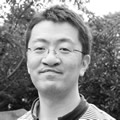
 Motoki Fujii teaches disaster prevention at the Department of Education of Shizuoka University. During his undergraduate studies he did research on Kant and after he took up his post at Shizuoka University, he became involved in ethics education. Although there doesn’t seem to be much in common between Kant’s philosophy which he studied at university and the kind of ethics taught as part of compulsory education, in the spring of 2009 he and some students, who were aspiring to become teachers, embarked on the task of developing and implementing teaching materials for educators.
Motoki Fujii teaches disaster prevention at the Department of Education of Shizuoka University. During his undergraduate studies he did research on Kant and after he took up his post at Shizuoka University, he became involved in ethics education. Although there doesn’t seem to be much in common between Kant’s philosophy which he studied at university and the kind of ethics taught as part of compulsory education, in the spring of 2009 he and some students, who were aspiring to become teachers, embarked on the task of developing and implementing teaching materials for educators.
That was two years before Tohoku region was hit by an earthquake on March 11, 2011. “It would make sense to include disaster prevention in the curriculum for this year’s ethics classes,” suggested the students from his research group in this year. They started reading through materials for disaster prevention that were already available in order to find something that could be incorporated into ethics classes. Eventually, after many discussions, they came up with a program comprising two parts: “Dilemma” and “Breaking Dilemma”.
During the first part, children engage in talks on the subject of moral dilemmas. Here is an example. Children are presented with the following situation: “You are a cameraman. There is an earthquake and you hear people crying for help. Do you help them or you continue covering the earthquake for the news?” Children are asked to choose a position and give reasons for their choice. Of course, that’s not all. The original position of the students may be shaken as a result of comments by their classmates or questions by the teachers. Depending on how much their conviction is shaken, some may feel compelled to change their position several times. Gradually the reasons given by the children become more complex and difficult to fit within the initial dichotomous choice. Fujii attaches a lot of importance to this process of self-examination. When faced with a dilemma to which they have no answer, children get the feeling of being at an impasse and in order to avoid such a feeling they make every effort to come up with a strategy.
During the “Breaking the Dilemma”, students are looking for advance preparation solutions, in order to improve the options for a course of action when disaster strikes. Children think of measures within their immediate surroundings and share concrete steps for the purpose of disaster prevention action. In this way, the philosophical quest for disaster prevention measures gets connected to the “action” that follows.
The attempt at teaching disaster prevention in ethics classes became an important project of the research group and attracted the attention of both seismology researchers as well as many media outlets. The task of the members of Fujii’s research group is devising an evaluation method, which includes examining the pros and cons of introducing disaster prevention into school curriculum. Evaluation according to the theoretical framework of ethics education as well as improvement of critical thinking skills could potentially serve as a benchmark. However, the purpose of the class is to teach children to be able to take disaster prevention action based on their own thinking and devise a strategy worth implementing when disaster strikes. We need to repeatedly question the purpose of the evaluation.
The task of the teacher is to ask questions.The implementation of this class would require a big shift in the role of the teacher because the main goal of the dilemma class is not finding the right answer but suggesting solutions. The teacher does not need to teach different viewpoints. Rather, by asking questions he needs to stimulate the children to think in various directions. That’s why the most important skill is to question things. For both the teacher and the children, the class is a place to practice philosophical dialogue.
Until now, in ethics classes in Japan most efforts were devoted to nurturing a compassionate heart in children and those of them who became aware of that, would choose as a right answer the virtuous action desired by the teacher. Fujii, on the other hand, is striving for the kind of education where children would acquire the skills to come up with their own reasons, talk about them and act accordingly, without the teacher showing them the right answer. The children in the classes of Fujii are surprisingly talkative. After the 3.11, Shizuoka Prefecture is gripped by anxiety that an earthquake could hit the Tokai region where Shizuoka Prefecture is located as well, and having a concrete topic to explore ignites the children to talk.
“If we describe the goal of disaster prevention education in Kant’s terms, it would be going from heteronomy to autonomy…,” says Fujii at the end. At the beginning he did not think of a connection between Kant and disaster prevention education. Now, however, he sees how his research on Kant, ethics education and disaster prevention are becoming interconnected into something that can be called “Disaster Prevention Ethics”. May be it was the philosophical dialogue between teacher and students that made him aware of that.

The English edition for this volume is now available on the following Kindle stores in the world.
■Japan: Amazon.co.jp
■USA: Amazon.com
■India: Amazon.in
■UK: Amazon.uk
■Germany: Amazon.de
■France: Amazon.fr
■Spain: Amazon.es
■Italy: Amazon.it
■Brazil: Amazon.br
■Canada: Amazon.ca
■Mexico: Amazon.mx
この投稿文は次の言語で読めます: Japanese